In what will be one of the marquee matchups for matchday two of the European Championships, France play the Netherlands in what will likely be the match that determines the winner of Group D. Both nations got off to winning starts in their group, with the Netherlands leaving it late to beat Poland 2-1, and France escaping with a 1-0 result against Austria, though they did lose their captain and superstar Kylian Mbappé to a broken nose.
This tactical analysis will examine how both sides fared tactically in their first matchups and potentially what to expect from Ronald Koeman and Didier Deschamps regarding potential tactical tweaks. These two nations are looking to essentially confirm a first-place finish in Group D.
Predicted Netherlands starting XI
In similar fashion to their opening match win against Poland, Ronald Koeman will likely set his Dutch side up in a 4-2-3-1 formation.
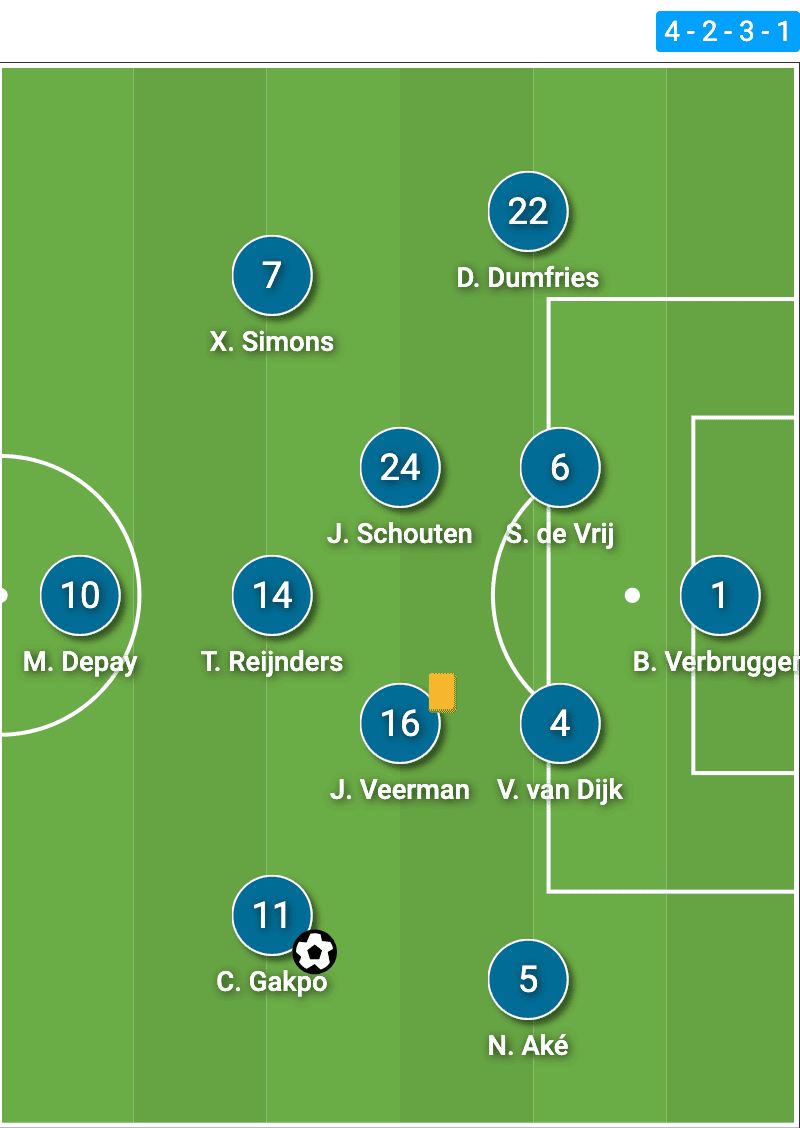
The image above from Wyscout shows how the Dutch set up in that 2-1 win against Poland, and we expect most of the starting XI to stay intact, but Koeman could make a few changes. The back five will likely be unchanged, though there could be a potential change in the defensive midfield position, with Georginio Wijnaldum a potential option to start in place of either Joey Veerman or Jerdy Schouten, especially with Veerman being on a yellow card, a second would result in a one-match suspension.
Liverpool’s Cody Gakpo and AC Milan’s Tijani Reijnders are in line to keep their place, but Xavi Simons could be someone who Koeman opts to start from the bench after his rather lacklustre showing against Poland. Donyell Malen or Jeremie Frimpong could be options for the Dutch in this position. Up front, Wout Weghorst made an instant impact off the bench late on, scoring the winner against Poland, but he likely will continue to be a super sub for Koeman, with Memphis in line to retain his place leading the line.
Predicted France starting XI
The big concern for Didier Deschamps and France going into this match is the status of Kylian Mbappé. The France captain broke his nose against Austria, putting his availability for this match in doubt.
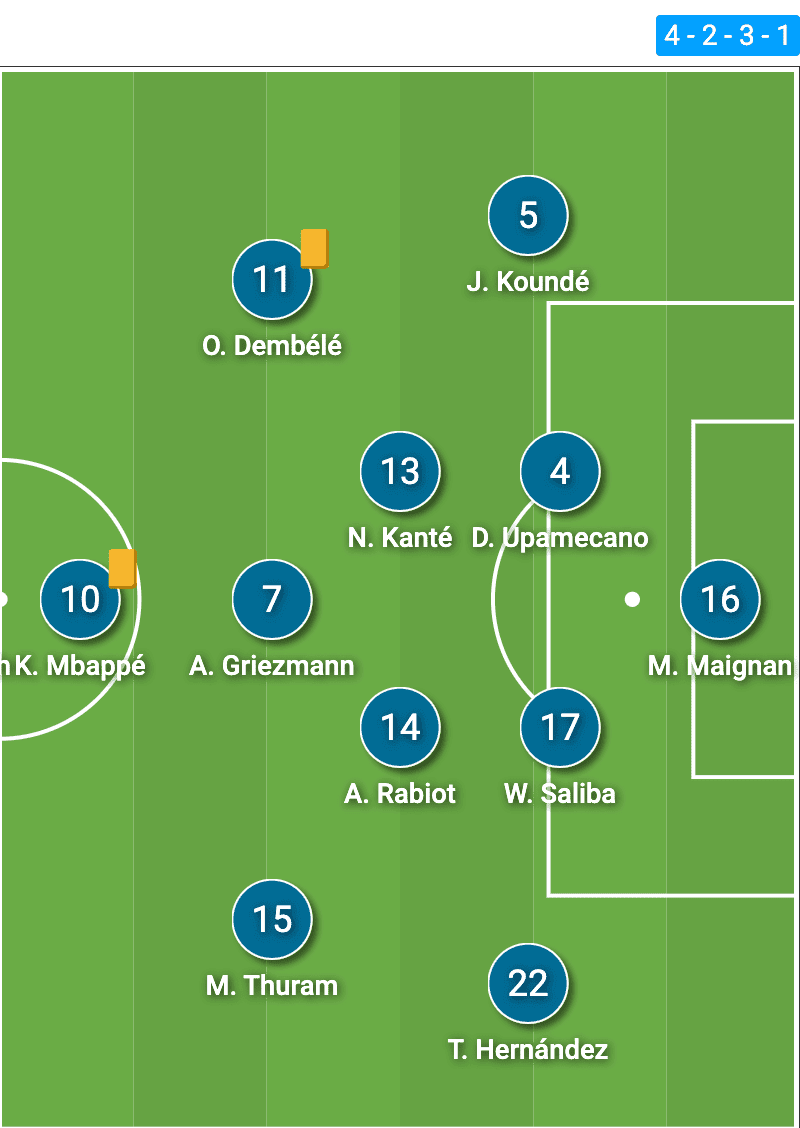
Above, we can see how Deschamps set his side up for their 1-0 win over Austria, with France also favouring a 4-2-3-1 formation. It would be unsurprising if the only change Deschamps makes is replacing Mbappé, with the question then turning to who starts in his place. It will likely be one of either Olivier Giroud or Randal Kolo Muani. However, Deschamps could also opt to move Marcus Thuram into a central striker position, one he found himself in often in the match against Austria.
If this were the case, Kingsley Coman or Bradley Barcola could find themselves in the starting XI, though Deschamps will likely look to keep more consistency in his starting lineup. Our prediction is that Giroud replacing Mbappé is the only change for France for this crucial group stage match against the Netherlands.
Dutch danger from the half-spaces and wide channels
In their match against Poland, the Netherlands caused constant problems down the flanks and half-spaces, with these areas of the pitch in the final third being where they caused Poland plenty of problems.
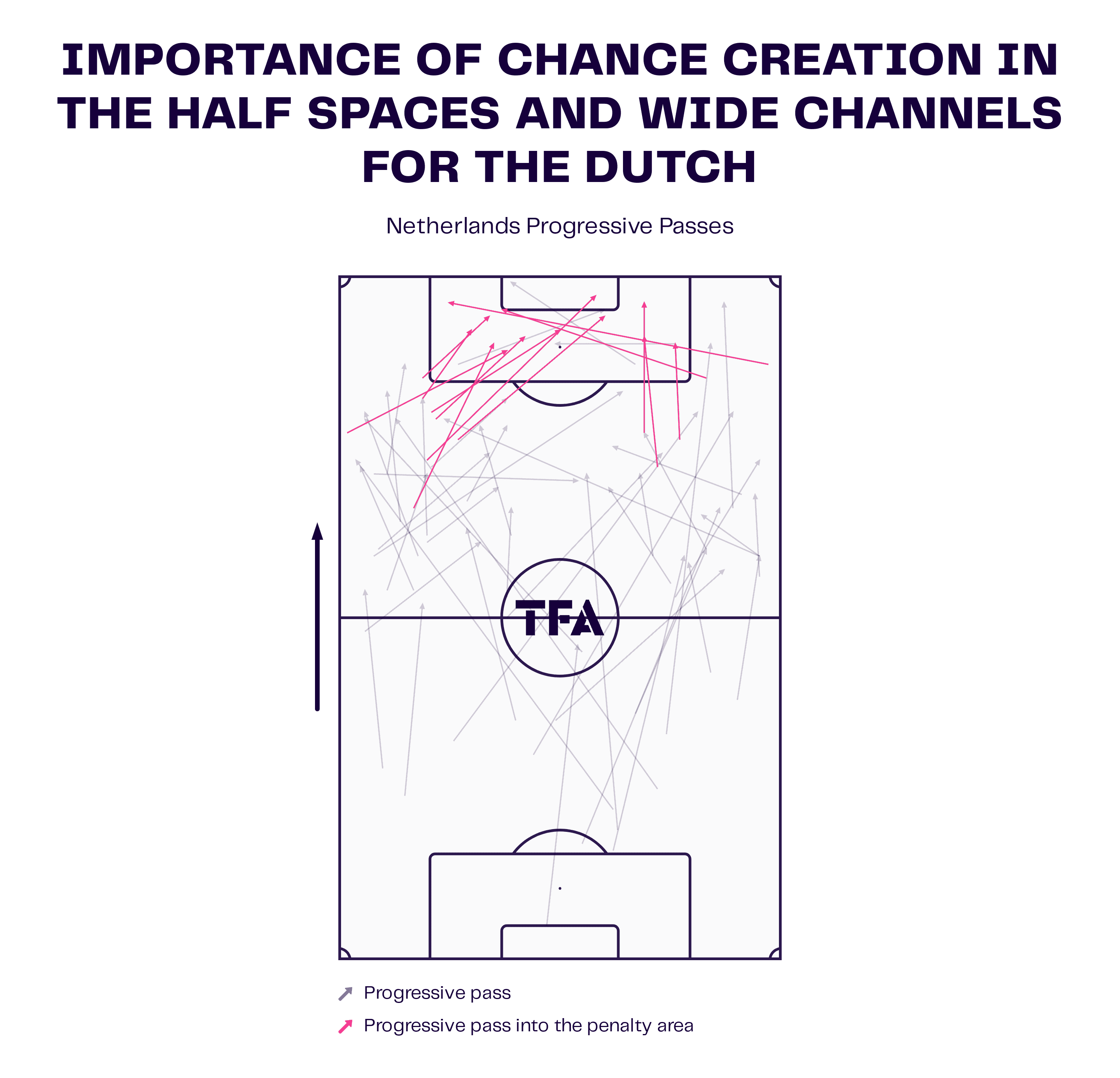
We can see from the data viz graphic above just how useful these areas were for Koeman’s side when it came to chance creation. All of the progressive passes into the penalty area from the Dutch came from either the half-spaces or wide areas, with essentially all of them occurring in the final third. Cody Gakpo had a very good match on the left side of the attack, with the Liverpool winger looking to stay high and wide to trouble the Polish defence down this side, looking to take advantage of Przemysław Frankowski down that side, with the Lens wingback more of an attack-minded wide defender.
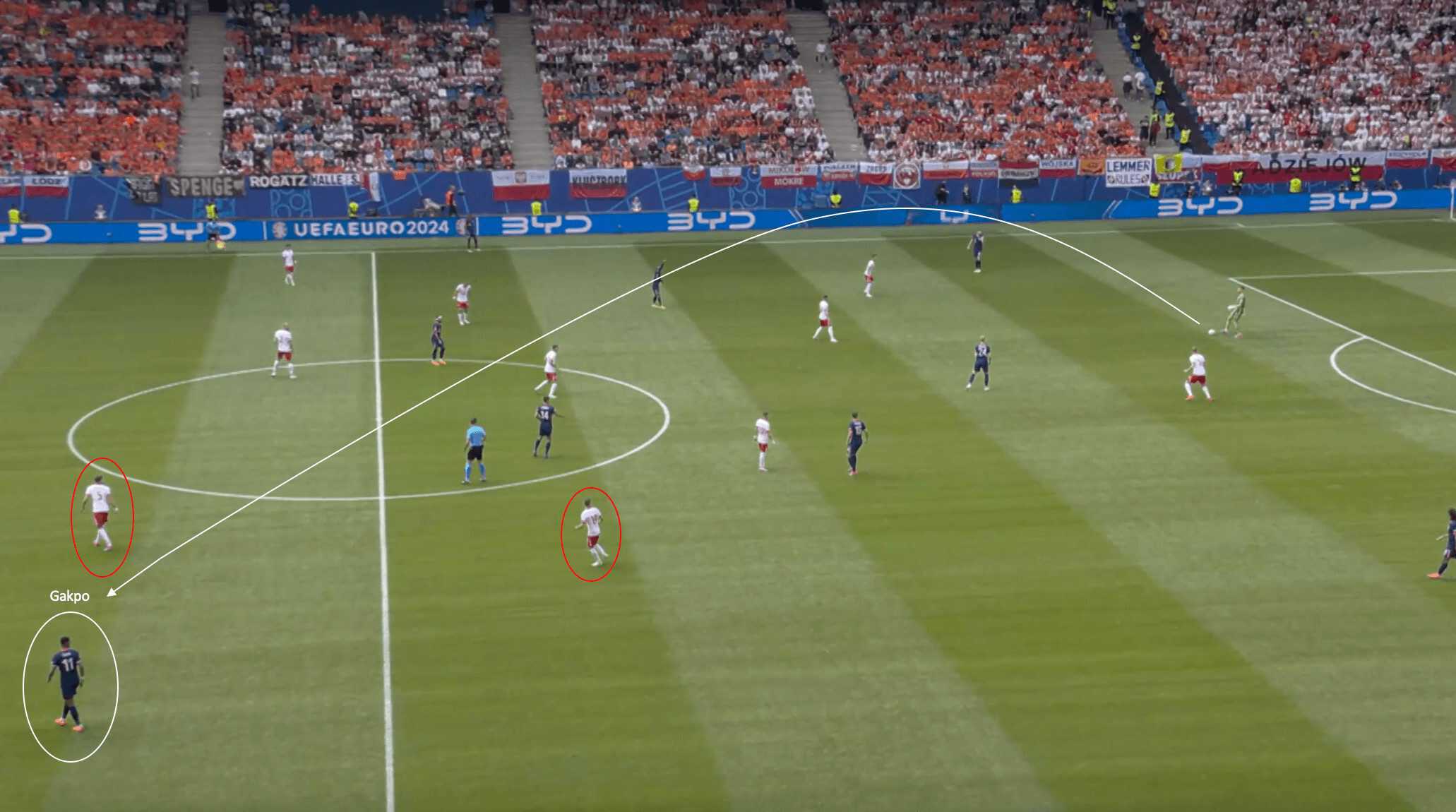
The image above shows an excellent example of how Gakpo looked to position himself in this match against Poland, showing how the Dutch looked to exploit space out wide to create chances from these areas. With the ball in possession of goalkeeper Bart Verbruggen, Gakpo is the highest-positioned Dutch attacker, but he is holding his wide position instead of looking to invert inside to a more central position. Frankowski is still pretty advanced for Poland, operating in the midfield, with centre-back Jan Bednarek being the only player close enough to challenge Gakpo when he receives possession.
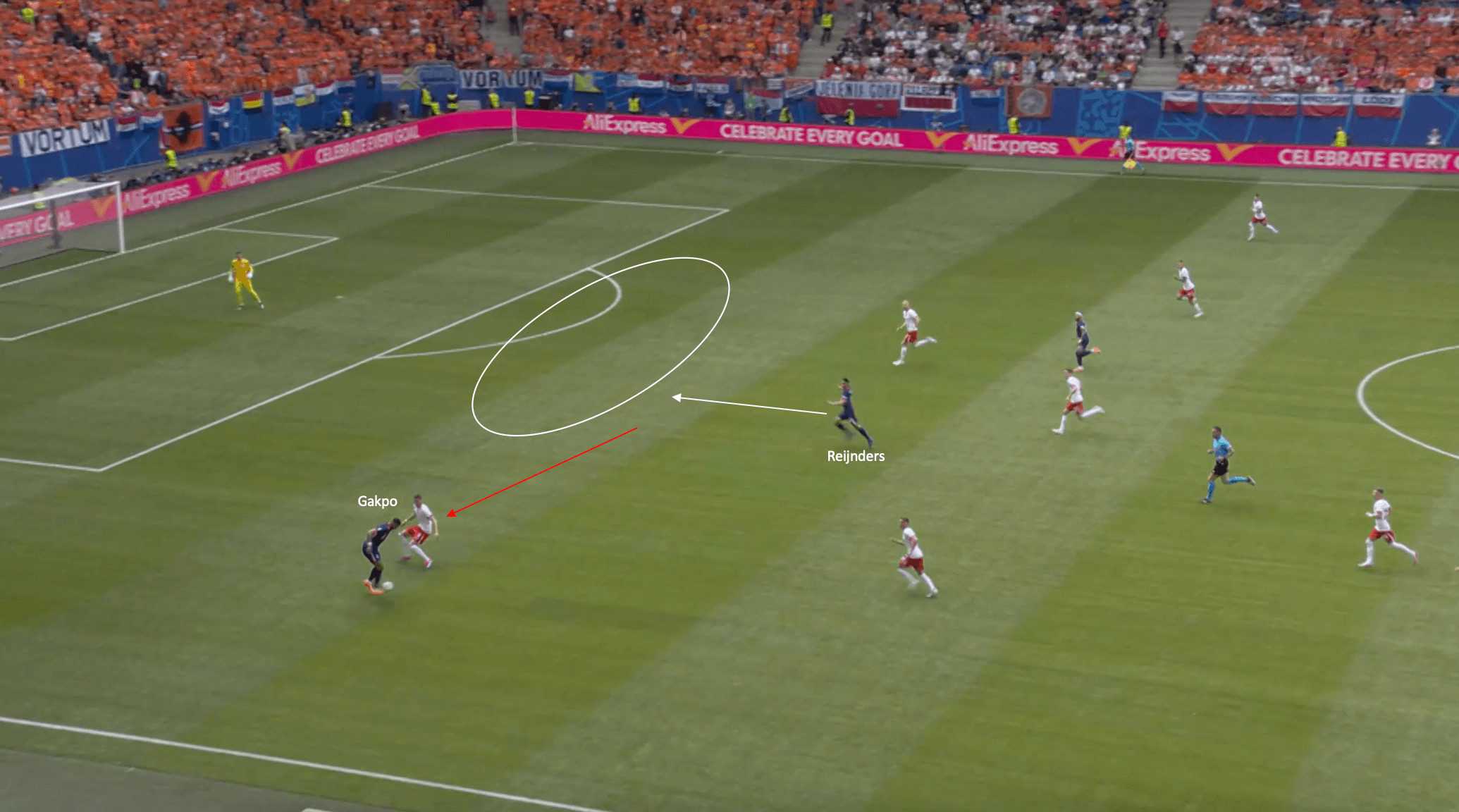
This next image shows what happens as the play progresses. The ball is played to Gakpo by Verbruggen, with Bednarek moving wide to mark him as Frankowski struggles to recover defensively. However, the Polish central defender’s movement opens up a massive gap centrally for Tijani Reijnders to run into, though Gakpo is not able to get his touch under control quick enough to slot him through.
He does end up finding Memphis unmarked in a central position, with the former Atlético Madrid forward able to play a one-two with Gakpo as he runs beyond the Polish defence. Unfortunately, the winger is not able to get a shot off as the ball is taken away from him by an opposition defender.
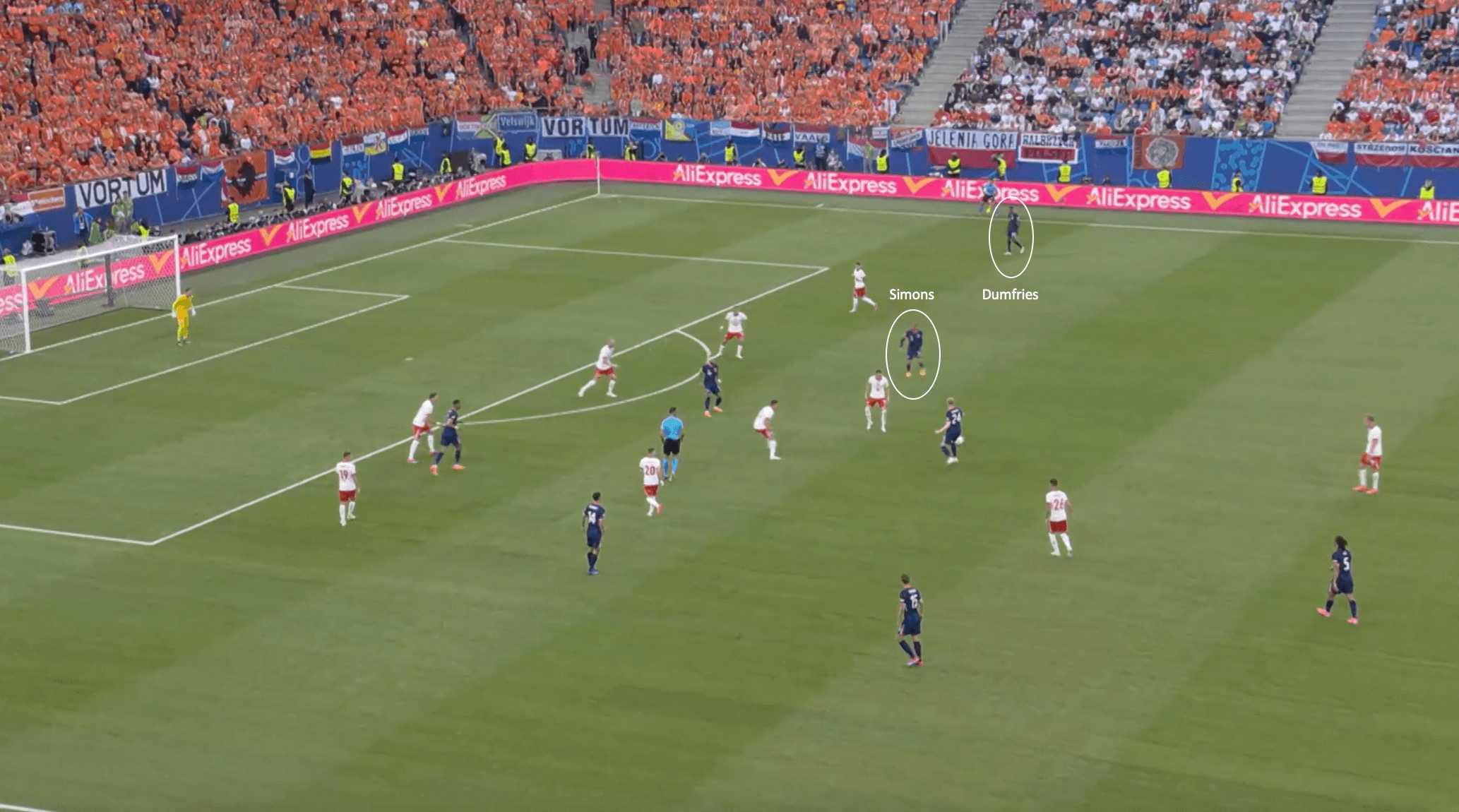
While France will have their hands full defensively dealing with Cody Gakpo down the left-hand side, they will also have problems on the opposite flank. Koeman wants his side to have maximum width at times, with the Dutch looking to stretch the opposition’s defence and open up pockets of space centrally for deeper-lying runners to run into and receive possession beyond the defensive line.
On the opposite side, the player tasked with holding the width for Koeman’s side in attack will likely be Inter Milan fullback Denzel Dumfries, with the 28-year-old one player who constantly looked to get forward into the attacking half against Poland. In the figure above, you can see the area where he will probably look to be, with the outside midfielder on this side, in this case, Xavi Simons, looking to operate in the half-space.
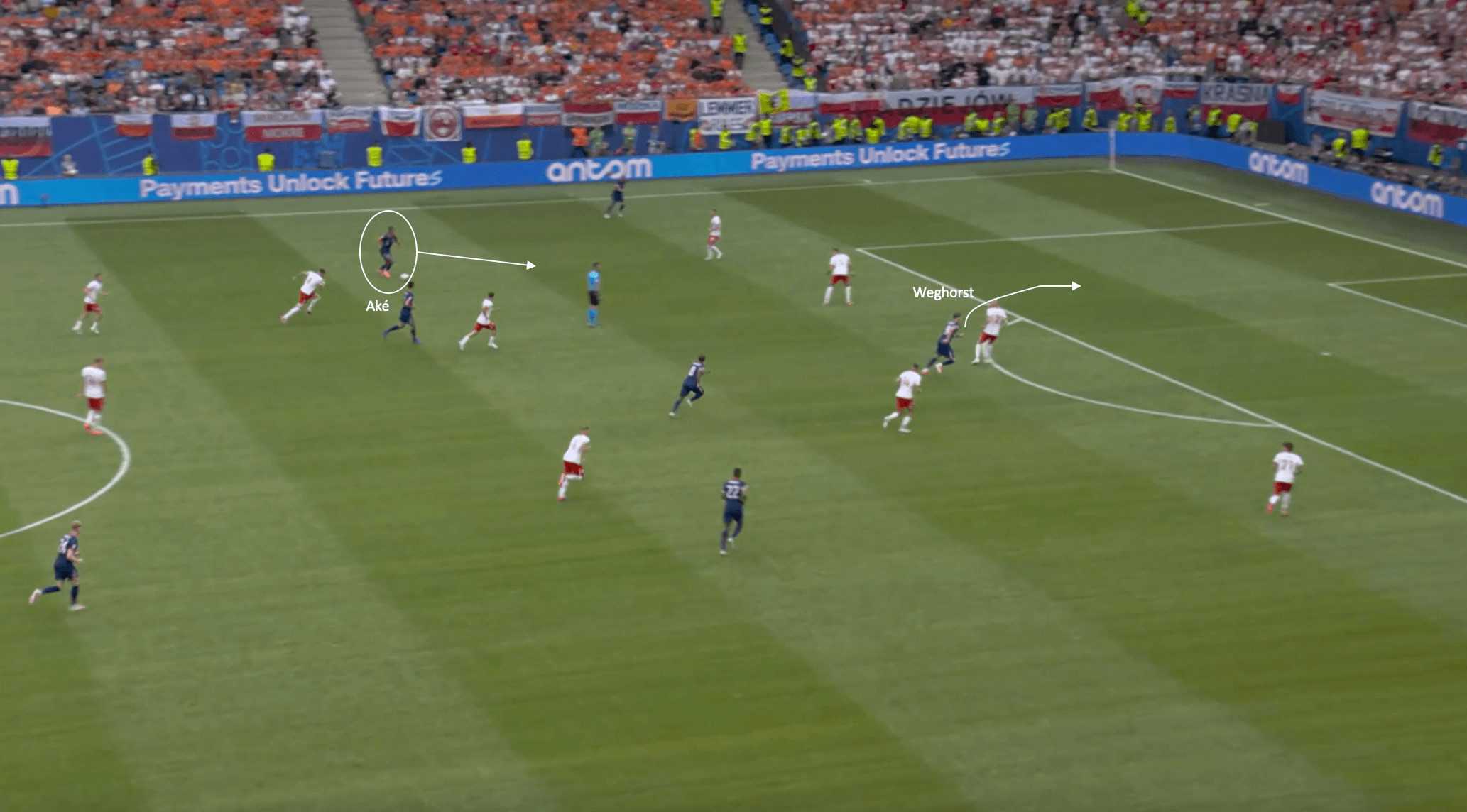
This final example looks at the build-up to the second goal from the Dutch against Poland. In this specific phase of play, the ball is played to Nathan Aké, with the Manchester City defender operating in the half-space as more of an inverted fullback. After receiving possession, he was able to drive towards the Polish backline, with the defender receiving possession in this area between the midfield and defensive lines. This allows the time for Wout Weghorst to run across his marker, with Aké able to play a ball into his path for the big striker to fire home first time.
France will have to be wary of how the Dutch operate in the attacking half of the pitch. Koeman’s side will likely look to exploit the wide areas and halfspaces again, and France will need to be aware of this.
Antoine Griezmann’s creative role for France
For France, we will take a look at the role Antoine Griezmann plays for the national team under Didier Deschamps. At the international level, the Atlético Madrid forward plays more of an attacking midfield role, usually sitting behind the central striker but also with the ability to roam around the pitch if needed. He tends to be the creative spark for this French side, and he will be even more important against the Netherlands with Mbappé likely ruled out of this match.
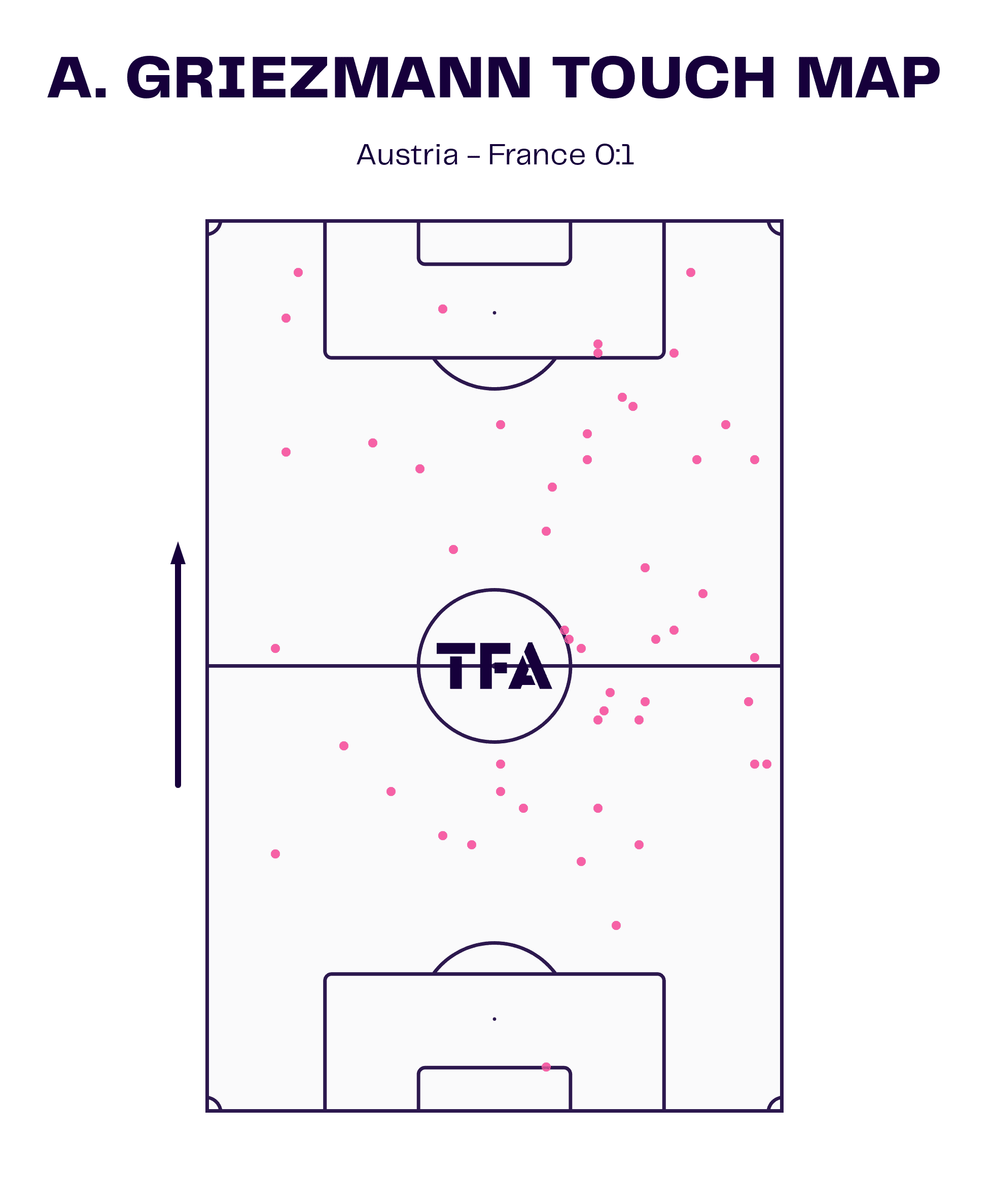
The graphic above shows Griezmann’s touch map from the match against Austria, and while he was limited in this matchup on the ball, we can still see how he looked to roam around the pitch to find areas to get on the ball and assist progressing play. He tended to be more active, drifting out to the right-hand side against Austria, which makes sense considering Mbappé played a lot off the left, allowing him to get matched up 1v1 against the Austrian fullback. However, he will likely look to be involved more against the Netherlands, and it would be unsurprising if Deschamps has a tactical plan to get the 33-year-old on the ball more.
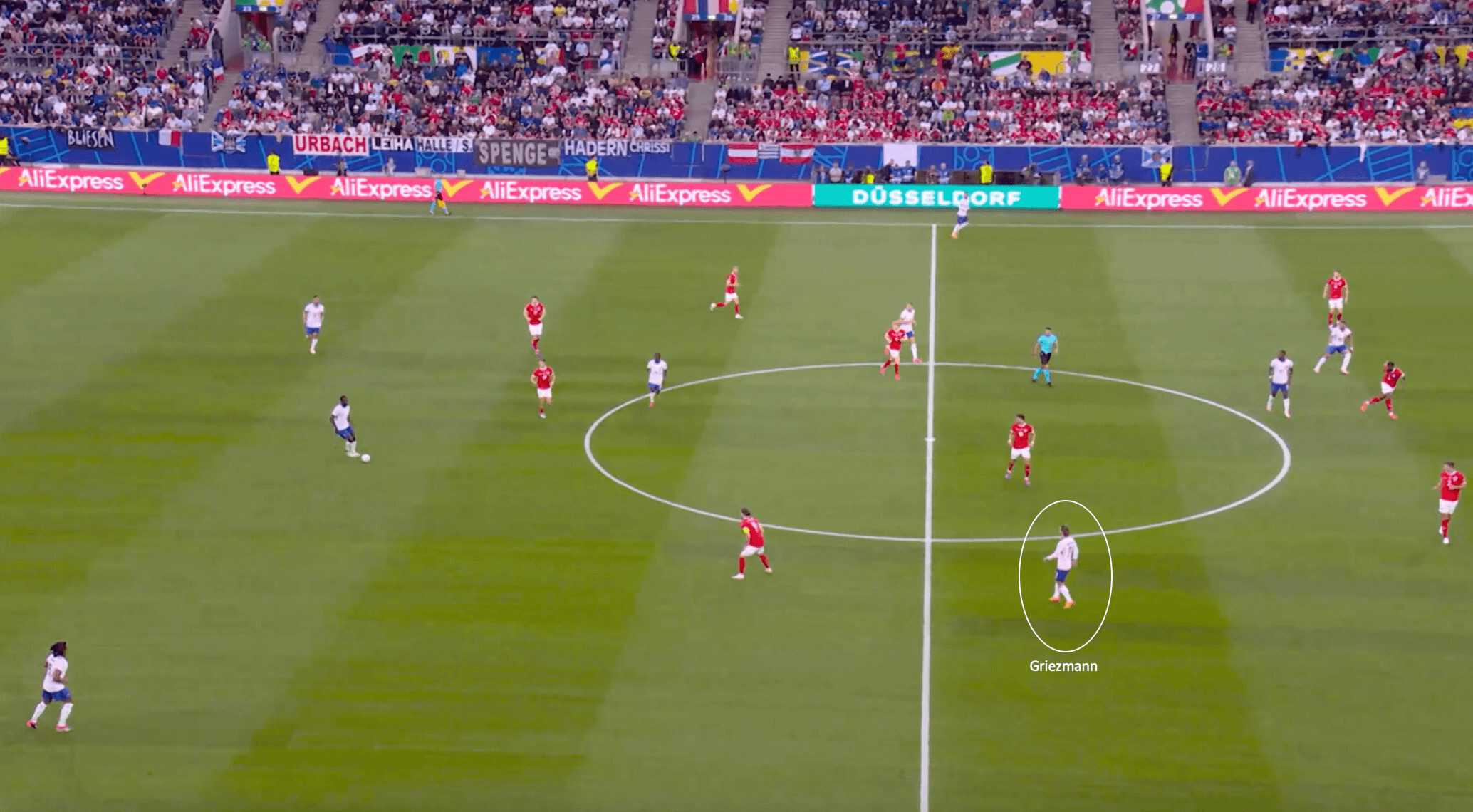
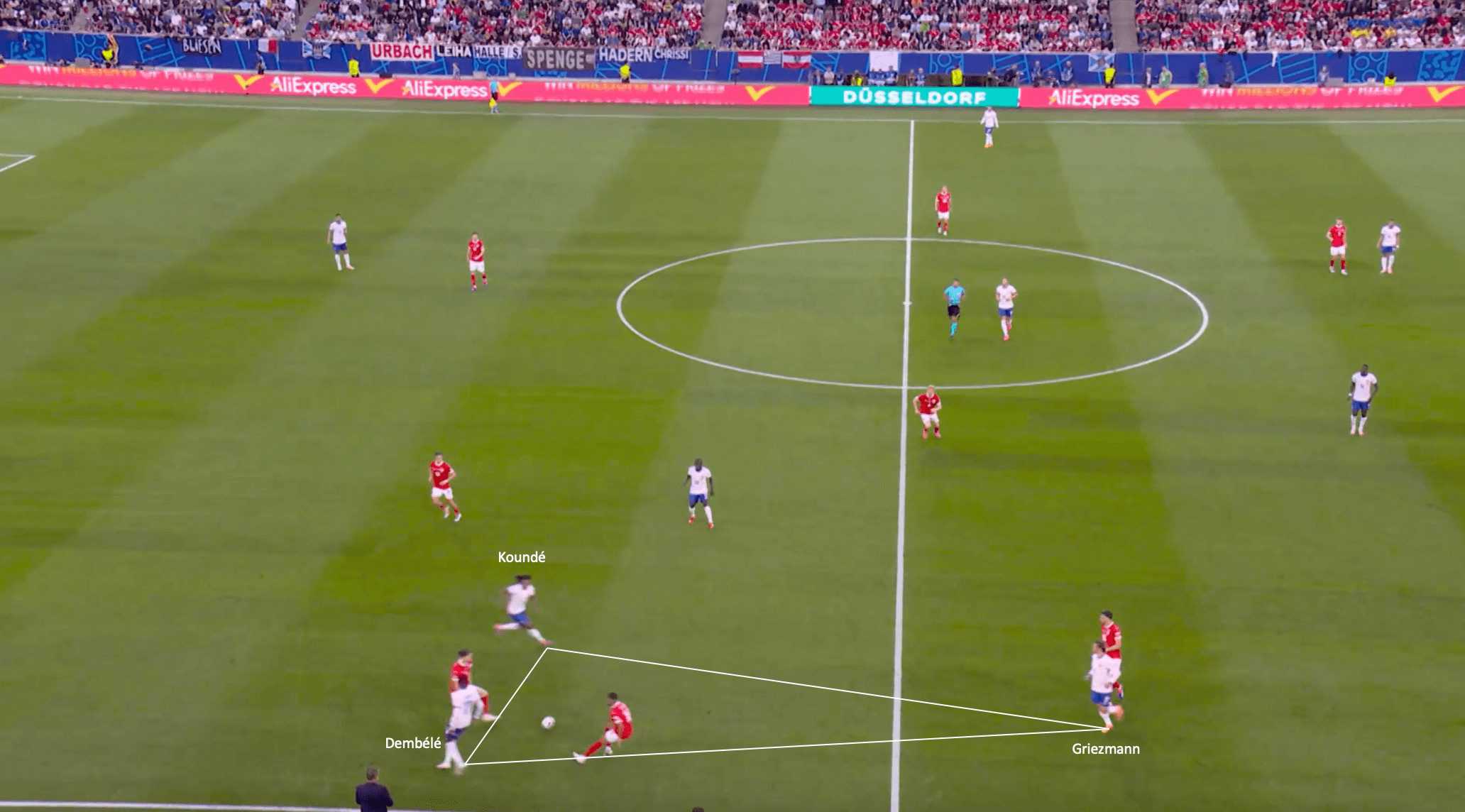
The sequence of images above shows an example of Griezmann’s movement and ability to roam around the pitch looking to get on the ball and progress play. In this phase of play against Austria, we can see how the 33-year-old starts in the right half-space, operating in a pocket between the midfield and defensive lines of Austria. As the play gets circulated to this near sideline, Griezmann looks to drift over and support.
As we can see from the second image, he has now formed a triangle with the right-sided attacking midfielder, Ousmane Dembélé, and the right back, Jules Koundé. Griezmann also does well in making sure he is in front of the defender, allowing him the best chance to gather possession if the ball finds him. As Dembélé finds Koundé inside, the fullback plays a pass to Griezmann, who does well to shield from the defender and play a first-time pass inside into the advancing run of Koundé. This allows France to escape the Austrian pressure and progress the ball into the attacking half of the pitch.
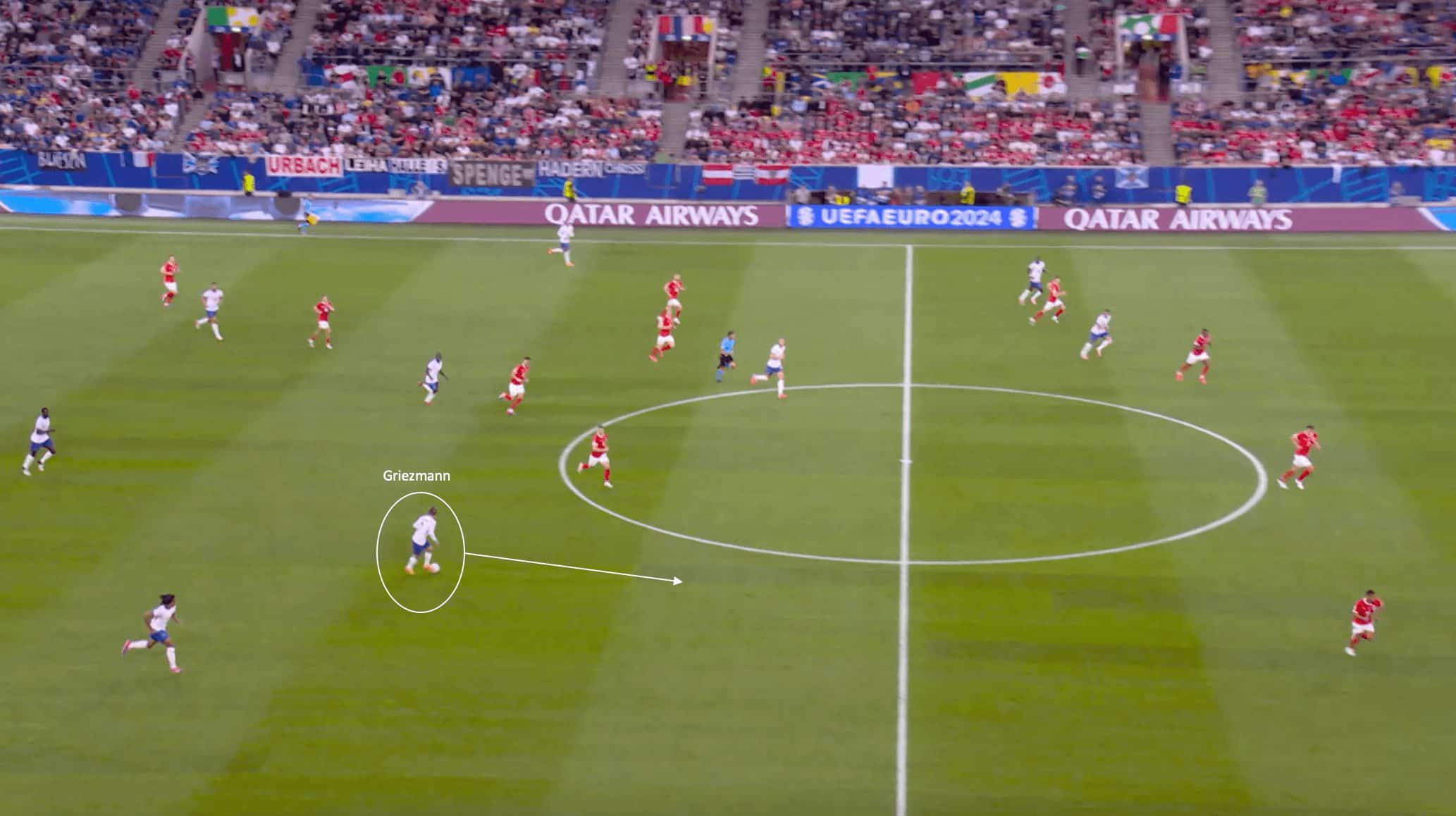
We can see again from the figure above how Griezmann will do what he needs to do to find the ball. In this example, he has dropped into a pocket of space in the defensive half of the pitch, with the 33-year-old picking up possession close to the defensive third of France. His smart positioning when receiving allows him plenty of space to turn and drive into, which he does before picking out the player in the wide channel just out of the picture.
The end result is a foul won for France near the edge of the Austrian penalty area, and it all started due to Antoine Griezmann’s movement off the ball and tendency to roam the pitch, looking to be the creative spark for Deschamps’s side. While Griezmann did not have the greatest match in a France shirt against Austria, he will need to step up against the Netherlands, and if he does, he will be a key contributor to everything Didier Deschamps wants his side to do, and the Dutch will have to be careful of Griezmann’s positioning on the pitch at all times.
Conclusion
As we have seen, both sides come into this match with momentum after winning their opening group matches. Both managers’ tactics will be interesting to see throughout the game as it progresses through different phases of the match, but these two tactical points analysed in this tactical analysis will be things that should feature prominently.





Comments